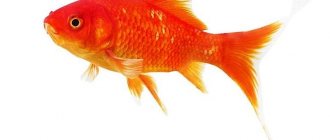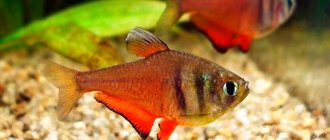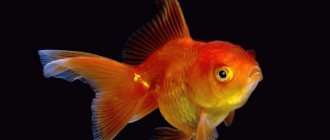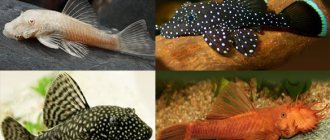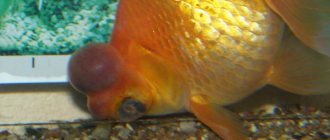A fish with the complex name Apistogramma Ramiresi, also called the veil butterfly or chromis butterfly, is an aquarium inhabitant that has a luxurious color, calm character and small size. These fish can get along peacefully with other inhabitants of the aquarium, which makes them universal pets and allows them to be added to an already populated tank. With such characteristics, it is not surprising that interest in the chromis butterfly among aquarists does not fade, and more and more aquarium lovers are acquiring these original pets - beautiful and positive.
Habitat in nature
A dwarf fish from the genus cichlids, Ramiresi's apistogramma, was first described by doctors J. Myers and Harry in 1948. Initially, it was scientifically called Paplillochromis Ramiresi and Apistogramma Ramiresi, but at the end of the last century the breed was renamed. Today it is correct to call these cichlids Ramiresi microgeophagus. They received this name in honor of the famous importer of aquarium fish, Manuel Ramirez. However, the old name is often used as it is more familiar.
The homeland of chromis butterflies is South America, or rather the Amazon River, but they do not live in the great river itself, but in the reservoirs that feed it. You can meet these fish in the basins of the Orinoco River. Most often, fish choose reservoirs with stagnant waters or weak currents, a sandy or muddy bottom and abundantly overgrown with plants as their habitat.
In nature, apistograms feed on what they get by digging in the soil mass - plant food and small insects. They can also get food in the water column, less often on the surface.
Compatibility
Despite the fact that their relatives are often distinguished by aggressive behavior, the apistogramma ramirezi is a peaceful fish that gets along well with similar gentle species. They are not like other cichlids. They do not have the habit of digging or damaging aquarium vegetation, making them an excellent option for a tropical home pond.
Viviparous, unpretentious fish, such as mollies, swordtails or guppies, will be excellent neighbors. They will also not offend neons, Rhodostomus rasbora and large shrimp. However, the fish fry will be mistaken for food, so in order to reproduce any species, the pair will have to be removed.
Description
The veil butterfly is a small fish with a bright color, an oval body and a high dorsal fin . In males it is more pointed, and they are larger than females - in the wild they grow up to 7 cm, in captivity - their length does not exceed 5 cm.
If the fish are kept in good conditions, they live 3-4 years, which is quite good for inhabitants of such modest size. Apistogramma Ramiresi immediately stands out among other aquarium inhabitants - with its luxurious, delicate fins and bright, attractive coloring. The fish have red eyes There is a spot of black on the body, and the fins are colored very bizarrely.
On sale you can find fish of this breed with a variety of colors - gold, electric, electric blue, and albinos are also common among apistograms. However, when purchasing pets with excessively bright colors, it is worth considering that such unusual colors are often the result of chemical dyes added to food or hormones. Such individuals often do not live long.
Reviews
Apistogramma Ramiresi is a beautiful fish with a luxurious color that can decorate any aquarium. You can watch the fish for hours. This is a universal individual that can get along with many inhabitants of the aquarium. It is not surprising that more and more aquarists are purchasing these original fish.
Want to buy a fish? Share in the comments!
What difficulties may owners encounter?
Ramiresi's apistogram does not require any complex care; it is enough to provide it with suitable conditions and appropriate nutrition. It is necessary to take care of stable water indicators: apistograms are very sensitive to changes in temperature, hardness, and acidity.
Most often, owners are faced with the fact that these fish darken and stop eating. This may be a reaction to stress, such as when a chromis butterfly is introduced to a new tank, or due to being kept in unsuitable conditions. If you take into account all the nuances, no difficulties or troubles will occur with your wards.
Adviсe
- Choose reliable aquarium heaters. A decrease in temperature to 20 degrees in the event of equipment shutdown will lead to the death of fish.
- In a medium-sized aquarium, maintain a group size of one male and three females.
- Give preference to an external filter, it filters water more powerfully and better.
- Live food can introduce parasites into the aquarium. Always process food before serving. Frozen foods are safer because freezing kills most unwanted organisms.
- When buying food for ramirezi, always look at the expiration date. Feed must be of high quality.
- Choose a solid dark background and soil for an aquarium with butterflies. Then nothing will distract you from watching interesting fish.
The fish had confusion not only in its names, but also in its genus. The species Apistogramma butterfly has been transferred by scientists from one genus to another several times. At first, the Ramirezi were classified as a genus of apistograms, which were later called microgeophagus, then pseudoapistogram and pseudogeophagus. Later, the Ramirezi again became microgeophagus.
Previous
FishDoctor Garra Rufa Fish
Next
Fish4 popular species of otocinclus catfish
How and what to feed butterfly fish
Like all cichlids, Ramirezi apistograms are practically omnivorous and have an excellent appetite. They can eat dry, live food, as well as substitutes. The fish really like live food: bloodworms, brine shrimp, coretra, cyclops, daphnia.
Cichlids take food from the surface and in the depths, but more often they “scour” along the bottom, collecting everything that remains and has managed to settle during feeding. It is important not to overfeed your pets, give them a varied, balanced diet. Another nuance - the pieces should not be large; if they are larger than the jaw apparatus of the chromis, the fish will not be able to eat it.
Owners can purchase pelleted diets designed for discus fish. When food granules settle on the ground, they do not dissolve immediately, and the fish have time to eat, collecting them from the bottom. If the tank contains only chromis butterflies, then you can give them any suitable diet.
In a community aquarium, it is advisable to feed them separately with sinking food, otherwise other inhabitants will eat the food before it reaches the lower water layers. When feeding frozen foods, it is advisable to let them thaw before serving and only then offer them to your pets.
Care
Mandatory butterfly care includes:
- weekly water changes;
- water quality testing;
- soil siphon;
- preparing a varied diet;
- timely detection and treatment of diseases;
- maintaining stable water parameters.
Combine soil cleansing with weekly water changes. Test your ammonia levels with water tests once a week.
Feeding
Butterflies tend to overeat, so feed the fish as much food as they eat in 5 minutes. After feeding, remove uneaten food particles. The omnivorous nature of fish allows them to have a varied diet.
Suitable frozen and live foods:
- bloodworm;
- daphnia;
- coretra;
- Cyclops.
Diversify your diet with plant foods:
- dandelions;
- nettle;
- cabbage;
- cucumbers;
- branded food.
Use dry food as a supplement to your diet.
Features of aquarium maintenance
Aquarists who have experience in keeping and breeding other species of Apistogramma - Agassica, cockatoo, high-finned, etc., will not have any questions. Ramirezis require almost the same care and conditions. Beginners should get acquainted with the features of these unusually beautiful cichlids and their requirements:
- butterfly fish are small and peaceful, so they can live in a small 25-35-liter aquarium, and a couple of chromis can be placed with other small and non-conflict residents;
- feed this miniature cichlid twice a day in small portions;
- Experts recommend changing water twice a week in small volumes, approximately a quarter of the total volume;
- chromis butterflies are calm and not prone to jumping out of the tank, so an aquarium lid is not necessary, but if there are other pets in the house that encroach on the aquarium inhabitants, it is better to install one;
- dwarf cichlids live in the bottom area and siphoning the soil is a mandatory procedure;
- apistograms need a variety of shelters - grottoes, caves, large stones, plants, driftwood, etc.;
- dwarf cichlids love to swim - when arranging a tank and installing various decor, it is important that there is free space for the free movement of the inhabitants;
- Experienced aquarists advise testing the water for ammonia and nitrate content when changing water;
- water indicators should be as follows: temperature from +22 to +28°C, hardness – 12dGH, pH – 5.5–7.5.
When purchasing dwarf cichlids, be sure to ask about the conditions in which the fish are kept. After all, while young animals of a given breed are able to adapt to new environmental conditions, adults rarely succeed in this. Quite often, fish die when faced with changes in indicators.
Aquarium professionals share a secret: when purchasing Ramiresi apistograms, it is recommended to take with you some water from the container in which the fish were kept. This will make it easier for them to adapt to new conditions.
Chromis do not require bright lighting, but if natural light penetrates little to them, it is worth considering artificial lighting of the aquarium. In addition, if you equip the tank with a special lighting device, the “butterflies” will literally shimmer under its rays, their color will noticeably intensify.
Feeding
The butterfly cichlid does not have specific taste preferences, and therefore can eat any food that is offered to it. Live food is good: plankton, daphnia, bloodworms, cyclops, tubifex, etc. You can also add special food for cichlids, sold in pet stores, to the diet. They come in frozen and dry form.
To ensure the full development of fish, it is important to follow the following rules when feeding:
- When feeding fish kept in an interspecies aquarium, sinking types of food should be used. This is due to the fact that ramizeri are modest in nature and do not immediately pounce on food. Therefore, more daring neighbors in the aquarium can get ahead of them.
- When creating a diet, you cannot stop at just one type of food (live or dry). The menu should be varied. Therefore, you need to include both types of food, observing the required protein intake.
Who do Ramiresi's apistograms get along with?
Experience shows that the most difficult relationships these tiny cichlids build are with their brothers. Males protect their territory from other males, which is especially evident during spawning - fights break out periodically. They coexist with other small fish without conflicts:
- red swordtails;
- veiled guppies;
- thorns;
- iris;
- zebrafish;
- neon;
- rasborami;
- lalius;
- non-aggressive small catfish;
- gourami;
- tetras;
- cockerels;
- parrot cichlids;
- scalars;
- small barbs and discus.
It is undesirable to house veiled butterflies with aggressive, predatory fish that are highly territorial. Larger inhabitants may consider small cichlids as food.
Diseases
Since Apistogramma Ramizeri belongs to the cichlids, she, as their bright representative, has good health. But this applies only to species that have not been subject to various changes. After all, to modify the color of their fish, owners resort to hormonal therapy, which undermines the health of their pets.
These fish do not have an innate predisposition to certain diseases, which means their health directly depends on the conditions of their detention. They are most influenced by water parameters and their sudden changes. If the temperature of the environment is lowered, its inhabitants will immediately become lethargic, begin to rise to the surface of the reservoir and gasp for air.
These diseases are widespread among butterfly cichlids:
- Ichthyophyriosis (or semolina). Symptoms: restless behavior, refusal to eat, convulsions, the appearance of white spots or inflammation on the scales.
- Lymphocystosis. Symptoms: convulsions, nervousness, the appearance of chaotic dark spots on the scales, gray nodes on the body.
- Hexamitosis. Symptoms: darkening of scales, apathy, loss of appetite, bloating, change in stool color, appearance of ulcers on the body.
Tuberculosis or dropsy may also sometimes occur. In this case, a characteristic signal of the disease will be swelling around the eyes.
If any of the symptoms are detected, contact your veterinarian immediately. Most diseases are curable only in the early stages. The specialist will select high-quality drugs and prescribe the correct treatment.
Reproduction Ramirezi
If these small fish are ready to breed in the aquarium in which they live, then the owner has provided them with the necessary conditions and is taking good care of his pets. Like their larger counterparts, these cichlids vigilantly guard the territory they have designated for spawning.
They begin to look for a site suitable for spawning in advance. Usually it turns out to be a shelter, a secluded corner, and having found one, they show aggression towards everyone who violates the boundaries established by the future parents.
In order for Ramirezi apistograms to unite in pairs, it is advisable to buy a flock consisting of 8-12 individuals. In this case, by the time of puberty, the owner will be able to discover that his charges have created pairs on their own. It is possible to obtain offspring of chromis butterflies only if the following rules are met:
- pairs must be created naturally - if you place separate females and males in a spawning tank, they will not produce offspring;
- the eggs mature and the fry are hatched without owner intervention;
- it is important to protect the family from stressful situations - noise, too bright light, temperature changes and other factors can lead to the fact that the fish, having experienced stress, will eat their offspring;
- to speed up the spawning process, it is recommended to increase the water temperature by 1-2°C.
An aquarist new to fish breeding may be frightened by the fact that the young “father”, for no reason at all, begins to swallow the fry. But this is not a fit of cannibalism, but care. Daddy simply transfers the babies to a special hole with an open top, where they will be safe for about another 3 days.
2-3 days after hatching, the fry can be given small food - Artemia nauplii, ciliates bred by tincture in an aquatic environment, dried banana peels or hay. Food is given to growing fish 5-6 times during the day. A good nutritious starting food is crushed yolk. A little later, young animals can include live food in their diet. In this case, daphnia and cyclops are suitable. 2-centimeter babies are already able to eat regular dry food.
If you do everything correctly, keep the water clean and take care of stable parameters, and most importantly, do not disturb the “parents”, after a while the fry will turn into adult, charming fish, and the aquarium will be replenished with new, cheerful and playful inhabitants.
Ramiresi's apistogram is a real, luxurious, bewitching “butterfly” of the underwater world that you can admire for hours. This fish can decorate any tank and become its full-fledged, peaceful inhabitant.
Breeding
Females and males of Ramiresi's Apistogramma choose their mates independently and do not change partners. It is better to purchase in groups of 6-10 individuals. They are classified as spawn-laying. They become sexually mature at 4-6 months, at which time the body length reaches 3 cm.
If favorable conditions are created in the aquarium, then spawning occurs without the intervention of the breeder. Producers carefully select and clean the site before laying eggs. They prefer smooth stones or wide leaf plates.
At one time, the female lays 150-200 eggs, which the male then fertilizes. It is important not to stress the fish, otherwise the offspring may be eaten before birth. The parents protect the clutch, but if there are other species in the aquarium, it is recommended to move it to a separate spawning tank.
To do this, a leaf or stone with eggs is placed directly in the water in a vessel so that the eggs do not oxidize during transfer and transferred to a prepared tank. In a new place, the leaf is secured with a clamp or attached to an artificial plant so that it does not float to the surface. The environment in the spawning tank must correspond to the parameters of a general aquarium. An aerator is placed next to the masonry, but it is directed so that there is no direct air flow. The light is scattered. The eggs are very sensitive and can be susceptible to fungal disease; to prevent this from happening, the water is heated to a temperature of +30...+32 °C and an antifungal agent is added. Whitened caviar is carefully removed from the clutch.
Under comfortable conditions, the larvae appear in 2-3 days. At first they feed on the yolk sac. After a couple of days it will dissolve, the fry will swim, and a microworm, ciliate or brine shrimp larvae will be added to its diet. The male may show aggression towards the female, then he is removed. In other cases, he takes responsibility for the entire flock or the pair divides it in half.
An interesting ritual is performed by the male in relation to newborns at the moment when they begin to swim. He takes them into his mouth, cleans them and releases them back or takes them to a prepared hole, where they continue to grow until they become stronger. This period lasts for 20 days, then the new father is sent away separately.
An important point for the full-fledged raising of offspring is their maintenance. A 10-15% water change is carried out daily, because the fry need a clean environment, free of impurities and food residues. To do this, add vegetation that does not require planting in the ground, for example, hornwort or riccia.
Photo of Ramirezi's Apistograms
Lifespan
In an aquarium with a water temperature of 25 degrees, the apistogram will live for about 4 years, and in water whose temperature is 27-28 degrees only 2-3 years. When selecting neighbors, you need to take into account that the fish loves warm water, so the neighbors should also be heat-loving. At the slightest drop in water temperature, they begin to suffer from ichthyophthyriasis (semolina).
General information
Apistogramma is the common name of a genus that includes 100 species. Small fish have a laterally flattened body of short length - from 2 to 8 cm.
The coloring is very bright, in most species combining several contrasting colors.
Particularly rainbow colors are observed in mature males, while fry or females look more modest.
Interesting! The word “apistogram” is translated from Latin as “a stripe curved on the side,” since such decoration is characteristic of most species. Such a line for the fish themselves is not an accessory, but an entire organ for capturing the direction of water movement.
Keeping beautiful apistograms in an aquarium cannot be called simple.
Before purchasing, it is better to gain experience with less fastidious fish or strictly follow the recommended rules for keeping apistograms.
View this post on Instagram
Publication from Muntyan Elena (@muntyan_elena) December 19, 2021 at 9:07 PST
Brief information
Apistogramma Ramiresi is a dwarf cichlid and is valued primarily for its attractive coloration, as well as its peaceful nature. The size of the fish allows it to be kept in small community aquariums. The aquatic organism owes its name to the Colombian researcher Vincent Ramirez, who discovered the fish in 1947.
A year later, the cichlid was given the scientific name Apistogramma and a corresponding description. In the 90s, there were repeated attempts to transfer the fish to the genus of microgeophagus, but despite the scientists’ contradictions, the first name took root better and was firmly established. If we consider the difficulties of care, then the Ramirezi apistogram is a rather problematic fish, but its decorative qualities significantly prevail over the disadvantages of keeping it.

